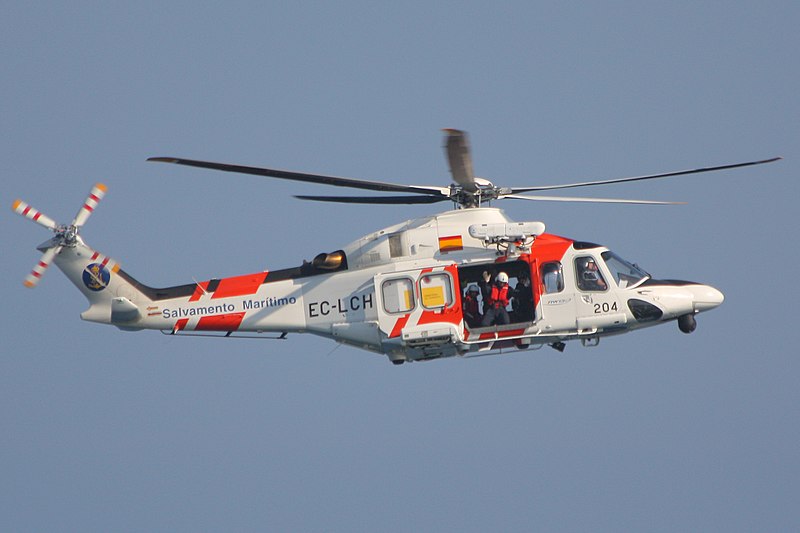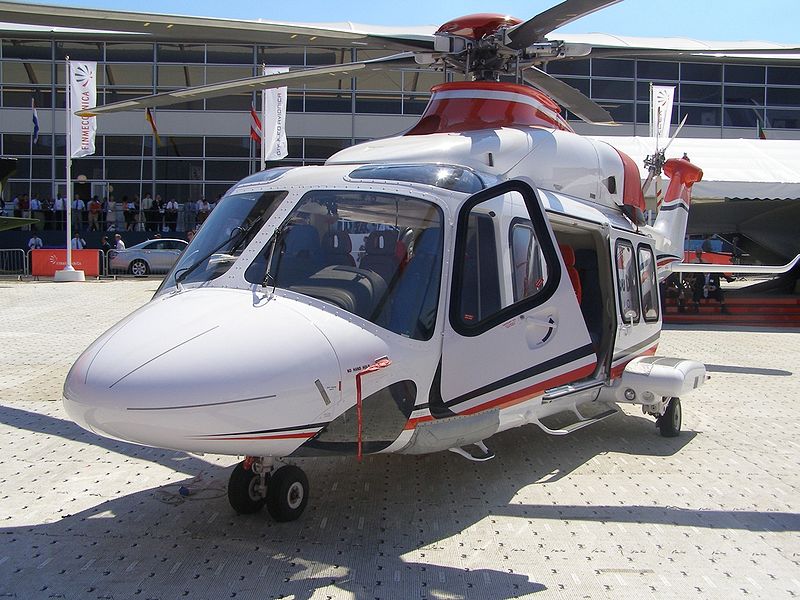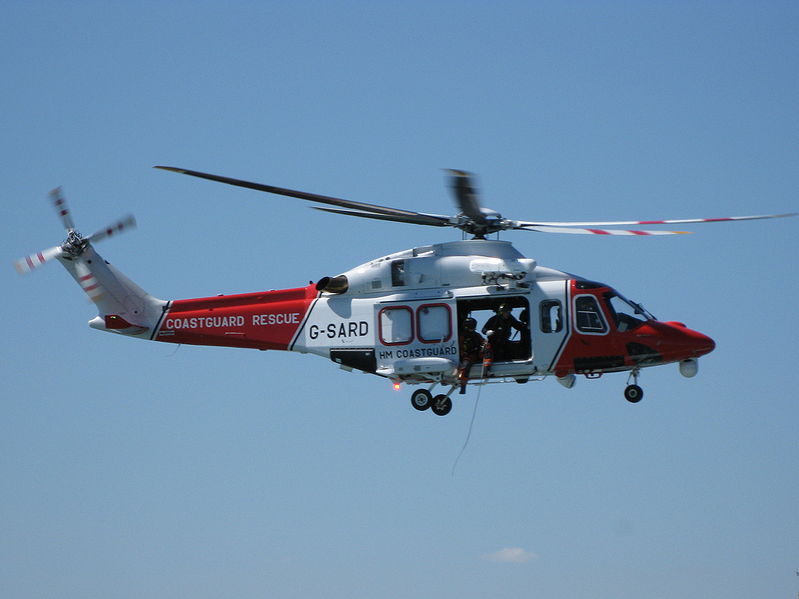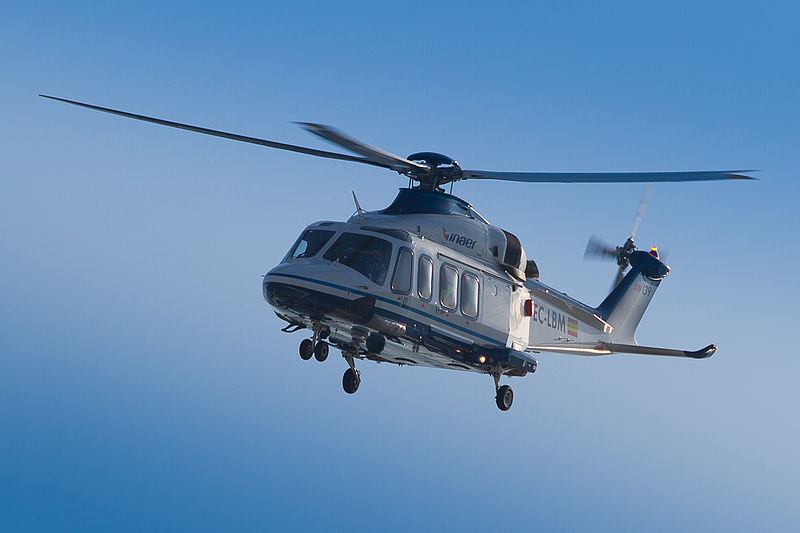بسم الله الرحمن الرحيم
انضمت حديثا هذا العروس للقوات الجويه المصريه
رابط

Role Medium-lift SAR/utility helicopter
Manufacturer AgustaWestland
First flight 3 February 2001
Introduction 2003
Primary users CHC Helicopter
Irish Air Corps
UAE Air Force
Number built 400
Unit cost $21 million
Developed into AgustaWestland AW149

The AgustaWestland AW139 is a 15-seat medium sized twin-engined helicopter manufactured by AgustaWestland. Originally designed and developed jointly by Agusta and Bell Helicopters and marketed as the Agusta-Bell AB139, it was redesignated the AW139 when Bell withdrew from the project. The AW149 is a medium-lift military helicopter being developed as an enlarged version of the AW139.

In 1997, the Italian helicopter manufacturer Agusta launched a programme to develop a replacement for the Bell Huey family of helicopters, which had been built in very large numbers both by Bell and Agusta, with a potential market of 900 aircraft being predicted. In 1998, Bell and Agusta entered into an agreement, setting up a joint venture, Bell/Agusta Aerospace Company (BAAC) to develop both the Italian helicopter and a tiltrotor aircraft, which became the Bell/Agusta AB139 and Bell/Agusta BA609 respectively.[1]
The AB139 is a conventional layout twin-engined transport helicopter. It has a five-bladed fully articulated main rotor with a titanium hub and composite blades and a four-bladed tail rotor. It is fitted with a retractable tricycle landing gear. It is flown by a crew of two pilots, with up to 15 passengers accommodated in three rows of five. It is powered by two Pratt & Whitney PT6C turboshaft engines.[2]
The helicopter is being marketed for use in a number of roles including Law Enforcement/Emergency Medical Service, Executive Transport, Search and Rescue, Maritime and Offshore Oil Operations.
The first orders were placed by Bristow Helicopters on 26 September 2000. The first AW139 flew on 3 February 2001 at Vergiate in Italy,[3][4] and the first production aircraft on 24 June 2002.[5] The first customer aircraft was delivered in 2003.
The company has orders for over 430 helicopters of which over 200 had been delivered by January 2009. It was a contender in the U.S. Army Light Utility Helicopter Program (2004–2006), but lost to the Eurocopter EC145-based UH-72A Lakota.
In 2007 a second production line at the AgustaWestland Aerospace plant in Philadelphia, United States was established.
At the Farnborough Air Show in 2006, AgustaWestland announced the AW149 as a multi-role battlefield helicopter variant of the AW139.
The Irish Air Corps began taking delivery of its first AW139s in 2007. The type will provide army co-operation capability to the Air Corps. They replace the Aerospatiale Alouette III in service.
In late 2006 it was announced that the Japan Coast Guard had selected the AW139 as the replacement for its fleet of Bell 212 helicopters. Twenty-four AW139s are expected to be delivered, beginning in 2008.
In June 2010, it was announced that Agusta and Rosvertol (Russian Helicopters) would build a plant in Tomilino, Moscow Region, jointly producing AW139s from late 2011.[6]

Notable accidents and incidents
3 June 2008, ADA, A6-BBB Abu Dhabi Aviation, UAE. CFIT.
25 August 2009, Gulf Helicopters, A7-GHC Doha, Qatar. Tail boom failure on ground.
2010 Spanish Maritime Safety Agency AW139 crash: On 21 January 2010, Spanish Maritime Safety Agency AW-139SAR (registration EC-KYR), crashed into the sea close to Almeria. 3 people died.[8]
3 July 2010, B-MHJ Hong Kong, ditched into Hong Kong harbour after technical problems.
23 February 2011, South Korean Coast Guard AW139 went missing off the southern island of Jeju. 5 people died.[9][10]
2 May 2011, Gulf Helicopters, Doha, Qatar, Tail rotor failure on ground.
30 June 2011, Kuala Lumpur, Westar Aviation AW139 made a hard landing.
17 August 2011, Beijing Municipal Public Security Bureau AW139 aircraft went missing into a reservoir in a northern suburb of Beijing (China), with five people aboard.Two confirmed fatalities, two missing.
August 2011, a Petrobras-charted AW139 helicopter crashed into the Atlantic Ocean, killing all four people on board the aircraft.

هي طائرة مروحية متوسطة تعمل بمحركين ، صنعها عمالقة شركات العالم " برات ويتني من كندا " ، " هنيويل من امريكا ، سويدنك من بولندا ، يبهر الالمانية ، كوازاكي اليابانية " .
لها استخدامات حربية ومدنية في نفس الوقت ، فيمكن لها حمل أكثر من 15 فرد او 2500 كجم من المعدات ، ويمكن استخدامها مدنيا في عمليات نقل الركاب او مطاردة الخارجين عن القانون ، ومهام البحث والانقاذ .
يمكن لهذه المروحية التسلق بمعدل 10.9 متر في الثانية ، ويمكنها الطيران حتي سرعة 310 كم/س ، ويصل مداها الي 1250 كم ، وارتفاعها الي 6096 متر ، ويمكنها ان تطير لمدة خمسة ساعات و 56 دقيقة ، واقصي وزن لها عند الاقلاع 6400 كجم .
وتعمل AW 139 بمحركين تقدمهم الشركة الكبري في هذا المجال " برات ويتني " طراز PT6C-67C ، ويمكن للطيار التحكم الرقمي بالكامل في المحرك .
وهذا المحرك قوته القصوي هي 1531 حصان لكل محرك من الاثنان علي متن المروحية ، وبسبب قوة كل محرك علي حدة ، فيمكن الاستمرار في الرحلة بامان في حالة عطل احد المحركين .
بينما قدمت شركة " هني ويل " الامريكية القمرة الزجاجية الخاصة بالقيادة ، وزودتها بحاسوب يمكنه التوصل لحل المشاكل التي قد تواجه المروحية ، والمروحية مزودة باجهزه استشعار ، انظمة الكترونيات الطيران .


انضمت حديثا هذا العروس للقوات الجويه المصريه
رابط

Role Medium-lift SAR/utility helicopter
Manufacturer AgustaWestland
First flight 3 February 2001
Introduction 2003
Primary users CHC Helicopter
Irish Air Corps
UAE Air Force
Number built 400
Unit cost $21 million
Developed into AgustaWestland AW149

The AgustaWestland AW139 is a 15-seat medium sized twin-engined helicopter manufactured by AgustaWestland. Originally designed and developed jointly by Agusta and Bell Helicopters and marketed as the Agusta-Bell AB139, it was redesignated the AW139 when Bell withdrew from the project. The AW149 is a medium-lift military helicopter being developed as an enlarged version of the AW139.

In 1997, the Italian helicopter manufacturer Agusta launched a programme to develop a replacement for the Bell Huey family of helicopters, which had been built in very large numbers both by Bell and Agusta, with a potential market of 900 aircraft being predicted. In 1998, Bell and Agusta entered into an agreement, setting up a joint venture, Bell/Agusta Aerospace Company (BAAC) to develop both the Italian helicopter and a tiltrotor aircraft, which became the Bell/Agusta AB139 and Bell/Agusta BA609 respectively.[1]
The AB139 is a conventional layout twin-engined transport helicopter. It has a five-bladed fully articulated main rotor with a titanium hub and composite blades and a four-bladed tail rotor. It is fitted with a retractable tricycle landing gear. It is flown by a crew of two pilots, with up to 15 passengers accommodated in three rows of five. It is powered by two Pratt & Whitney PT6C turboshaft engines.[2]
The helicopter is being marketed for use in a number of roles including Law Enforcement/Emergency Medical Service, Executive Transport, Search and Rescue, Maritime and Offshore Oil Operations.
The first orders were placed by Bristow Helicopters on 26 September 2000. The first AW139 flew on 3 February 2001 at Vergiate in Italy,[3][4] and the first production aircraft on 24 June 2002.[5] The first customer aircraft was delivered in 2003.
The company has orders for over 430 helicopters of which over 200 had been delivered by January 2009. It was a contender in the U.S. Army Light Utility Helicopter Program (2004–2006), but lost to the Eurocopter EC145-based UH-72A Lakota.
In 2007 a second production line at the AgustaWestland Aerospace plant in Philadelphia, United States was established.
At the Farnborough Air Show in 2006, AgustaWestland announced the AW149 as a multi-role battlefield helicopter variant of the AW139.
The Irish Air Corps began taking delivery of its first AW139s in 2007. The type will provide army co-operation capability to the Air Corps. They replace the Aerospatiale Alouette III in service.
In late 2006 it was announced that the Japan Coast Guard had selected the AW139 as the replacement for its fleet of Bell 212 helicopters. Twenty-four AW139s are expected to be delivered, beginning in 2008.
In June 2010, it was announced that Agusta and Rosvertol (Russian Helicopters) would build a plant in Tomilino, Moscow Region, jointly producing AW139s from late 2011.[6]

Notable accidents and incidents
3 June 2008, ADA, A6-BBB Abu Dhabi Aviation, UAE. CFIT.
25 August 2009, Gulf Helicopters, A7-GHC Doha, Qatar. Tail boom failure on ground.
2010 Spanish Maritime Safety Agency AW139 crash: On 21 January 2010, Spanish Maritime Safety Agency AW-139SAR (registration EC-KYR), crashed into the sea close to Almeria. 3 people died.[8]
3 July 2010, B-MHJ Hong Kong, ditched into Hong Kong harbour after technical problems.
23 February 2011, South Korean Coast Guard AW139 went missing off the southern island of Jeju. 5 people died.[9][10]
2 May 2011, Gulf Helicopters, Doha, Qatar, Tail rotor failure on ground.
30 June 2011, Kuala Lumpur, Westar Aviation AW139 made a hard landing.
17 August 2011, Beijing Municipal Public Security Bureau AW139 aircraft went missing into a reservoir in a northern suburb of Beijing (China), with five people aboard.Two confirmed fatalities, two missing.
August 2011, a Petrobras-charted AW139 helicopter crashed into the Atlantic Ocean, killing all four people on board the aircraft.

هي طائرة مروحية متوسطة تعمل بمحركين ، صنعها عمالقة شركات العالم " برات ويتني من كندا " ، " هنيويل من امريكا ، سويدنك من بولندا ، يبهر الالمانية ، كوازاكي اليابانية " .
لها استخدامات حربية ومدنية في نفس الوقت ، فيمكن لها حمل أكثر من 15 فرد او 2500 كجم من المعدات ، ويمكن استخدامها مدنيا في عمليات نقل الركاب او مطاردة الخارجين عن القانون ، ومهام البحث والانقاذ .
يمكن لهذه المروحية التسلق بمعدل 10.9 متر في الثانية ، ويمكنها الطيران حتي سرعة 310 كم/س ، ويصل مداها الي 1250 كم ، وارتفاعها الي 6096 متر ، ويمكنها ان تطير لمدة خمسة ساعات و 56 دقيقة ، واقصي وزن لها عند الاقلاع 6400 كجم .
وتعمل AW 139 بمحركين تقدمهم الشركة الكبري في هذا المجال " برات ويتني " طراز PT6C-67C ، ويمكن للطيار التحكم الرقمي بالكامل في المحرك .
وهذا المحرك قوته القصوي هي 1531 حصان لكل محرك من الاثنان علي متن المروحية ، وبسبب قوة كل محرك علي حدة ، فيمكن الاستمرار في الرحلة بامان في حالة عطل احد المحركين .
بينما قدمت شركة " هني ويل " الامريكية القمرة الزجاجية الخاصة بالقيادة ، وزودتها بحاسوب يمكنه التوصل لحل المشاكل التي قد تواجه المروحية ، والمروحية مزودة باجهزه استشعار ، انظمة الكترونيات الطيران .



